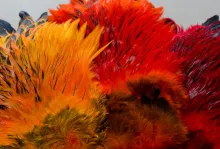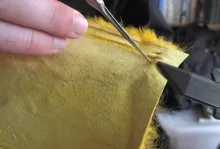What to look for when buying bucktail, a cheap and easily accessible and very useful fly tying material. Learn how to get the best quality for streamers, saltwater patterns and pike flies.
Bucktails are a very useful, inexpensive and easily accessible material, which is very useful for people tying larger flies like pike flies and saltwater flies, as well as people tying streamers of all kinds.
Bucktails are available in natural colors (white and brown) as well as almost any dyed color you can imagine.
When buying a bucktail, always get it out of the bag to inspect it. You are looking for nice, uniform, straight, soft hair. Depending on your use you might want finer and softer hair (traditional streamers), or coarser and longer hair (pike/saltwater flies). The longer hair sits on the sides and tip of the tail, and can be seen best from the back, while the shorter and more steeply tapered hair is in the center front and top of the tail.
Notice that the tail is darker in the center front, and that few dye jobs manage to get a totally consistent coloration of all hair. The center will usually always be darker, meaning that the brightly colored hairs are the longer side hairs. So a consistent dye job will rarely lead to a totally uniform color, but on the other hand often give some nice hues, like two tones of olive, gray and blackish, yellow and bright olive, which can all be useful. Black is usually the only color that penetrates all hair on the tail.
Make sure you see no broken tips on the hairs. The tapered tips are what's use in far majority of bucktail flies, and broken tips means that you will have to sit and remove single hairs once you have picked and/or stacked a bunch. The broken tips can also be a sign of a dry tail, which has been stored for a long time, and is getting brittle.
You want a flat and symmetrical skin and no curled parts - neither on the skin side or in the hairs. The hairs might be saved with washing or steam, but the skin is hard as wood, and not easy to straighten.
Bucktails are very prone to dirt (consider their placement on the animal!), so make sure you lift the hairs and check for patches of "mud" on the skin. Some of it can be washed off, but it's of course better and easier to buy skins that are clean from the outset.
Hand picked for this article
- Log in to post comments














